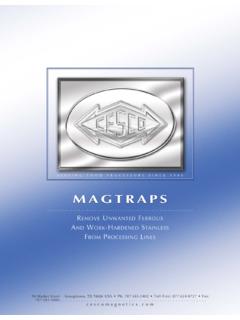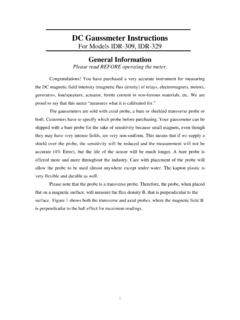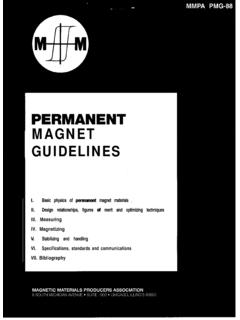Transcription of The CESCO Gauss Measurement System
1 Serving the Food Industry since 1946 Tel: 707-585-2404 Fax: 707-585-3886 The CESCO Gauss Measurement System Consists of: 1) gaussmeter , Serial Number_____ has four buttons and a 48 Flexible Probe. One end of the probe plugs into the top of the Gauss meter, the other end contains a very small (.2mm x .2mm ) flat hall-effect sensor beneath shrink wrap plastic. 2) Green Magnetic Viewing Paper - Allows see-through of the stainless steel enclosure to locate magnetic areas to measure and determine if individual magnets are broken or displaced. Depending upon the magnetic arrangement, places of maximum magnetism are show as light colored lines against darker paper. The gaussmeter measures magnetic flux density from 19,999 to +19,999 Gauss , a range capable of measuring all permanent magnet fields.
2 Factory calibration is valid for one year. This unit was calibrated at the factory using gap magnet #F062-10K (see certificate of calibration included with the meter). Accuracy of unit is +/- 2% over the temperature range of 30 to 110 Fahrenheit (-1 C to 43 C) in the dynamic range of 0 to +/- 20,000 Gauss . Minimum usable resolution is Gauss . Peak Hold capture time is seconds. A standard 9 volt alkaline battery powers the unit and is replaceable by removing the back panel. Battery is good for 40 hours of run time. The display shows LOWBATT when 1 hour of battery life remains (* Gauss and Tesla are units of magnetic flux density , not magnetic field strength . However, field strength is used for purposes of this instruction) DIRECTIONS FOR USE: A.
3 Plug the connector end of the flexible probe into the top of the Gauss Meter. The magnetic sensor is located on one side of probe end at the other end of the 48 long wire (4mm wide and thick) where it shows as a slight bulge beneath the covering shrink wrap. B. Turn the meter on by pressing power for at least one second. Assuming the unit is in zero magnetic field with the probe inserted into its socket, should appear on the digital display. C. With an ambient magnetic field, the offset buttons can be used to adjust up to 10 Gauss to bring the starting point to zero. D. To toggle between DC and Peak Hold mode press the power button briefly. To release the Peak Hold reading, press the auto zero button. E. Use Viewing paper to find magnetic areas to measure: see full instructions on next page.
4 F. To take a Gauss reading; place the probe with the bulge side against or perpendicular to the item being measured (see next page for probe orientation). Plus and minus readings are inconsequential as they merely indicate north or south polarity. G. Only measure the magnets at ambient temperature. Anticipate readings to decrease slightly during the first months as the magnets get worked . After that, the readings should stabilize and provide similar readings year after year if the readings are taken at the same place on the measured unit (important). H. Record where you took the Measurement . It is important to measure your magnet at the same place every time. Otherwise your historic recordings will be inconsistent. Magnet Notes If lost strength is identified, probable causes are: 1) The unit has been dropped and the magnets inside are broken, or have shifted.
5 When using the green viewing paper this shows up as uneven line(s). 2) The magnets have been exposed to excessive heat (maximum allowable temperature limits vary). 3) The magnetic element has developed a crack that has allowed liquid or air inside. The result of any of the above conditions can decrease or kill the magnetism, all or in part. (Over) CESCO Magnetics 90 Market Street Georgetown, Texas 78626 USA Gauss , n., after Karl Gauss (1777-1855), a unit used in measuring magnetic intensity equal to one line of force per square centimeter. MAGTRAPS & GRATES WITH MAGNETIC TUBES Each magnetic tube contains several magnets. To find the magnets and check for any damage place the green view-ing paper around a tube. Look for sharp crisp lines. The highest Gauss readings lie midway between the lines on the green paper.
6 Place the probe (as shown in figure 1) with the sensor side flat against the tube. Press down gently on the probe and slowly move up and down the tube to find the highest reading. Briefly press the Power button to toggle between normal and peak hold mode. The peak hold set-ting will display the strongest field (positive or negative). To reset the peak hold reading, press Auto Zero . Readings may not be the same across all tubes. Each magnet in the tube can have slightly different individual strength. Tips: Rather than measuring every magnetic place, select one Measurement point: example: use the centerline tube, at the bottom of the tube tip, typically about 1-1/4 ( cm) from the bottom of the tube. Measure and record the Gauss shown at that point. This assumes there is no damage to other tubes that may require measuring.
7 If a unit is dropped and the tube is unbroken, check the magnets with the green viewing paper. The lines should be sharp. If the lines are not straight and sharp, contact CESCO . MAGTRAPS WITH MAGNETIC PLATES Rare earth units have two measuring lines (one is shown by the viewing paper in figure 2). Units with ce-ramic magnets contain one line . On rare earth units, the lines are about 1 on either side of the centerline. On ceramic magnets, the line is slightly off center. Place the green viewing paper at the center and move it around to locate the line(s). One or two lines will ap-pear on the green paper. Using the Peak Hold set-ting on the meter, hold the probe perpendicular to the surface, move it along the line on the green paper until you locate the highest reading.
8 Record the loca-tion of the highest reading for future measure-ment. If the lines appear broken or uneven it is assumed that the unit has been dropped and the magnets have been broken or rearranged, therefore the original strength will probably not be attainable. If the lines appear broken or are not straight, contact CESCO . MAGNETIC PLATES MagPlates are usually in two forms flat face or stepped face. Lines appear at the places to be measured (shown above), and in the step of stepped units (shown at right). Hold the gaussmeter probe perpendicular to a flat surface of the magnet or at a 45 angle in a stepped surface (shown at right). Move the green viewing paper until you see a "light line" (there may be more than one). Move the probe along the line" until you obtain a satis-factory reading and record where reading was taken.
9 CESCO has produced many custom units that may not conform with these suggestions, however, these instructions should allow you to locate the places to measure your unit. Use the special paper to find the magnetic lines , or move a paperclip around on the magnet to indicate the places of maximum magnetism. 12/11 For questions or help, please call CESCO at 877-624-8727 PROBE at 45 angle Figure 1. Figure 2. Figure 3. Probe at 90 to face, aligned with line on green paper Page 2





